




Bhutan is renowned for the enduring strength and vitality of its traditional Himalayan Buddhist culture and the dominance & purity of its natural environment. This journey through the country’s west encapsulates both these elements. Touring the major historical centers and day hiking to some important sites are combined with stepping off the beaten track, into a world that not long ago existed throughout the country and for many still represents the norm. There is a particular emphasis on traditional arts and crafts, observing the perpetuation of skills that have been carefully maintained through the generations.
On this trip, you will come in contacts with Monpas, Bhutan's indigenouous tribe who still practises age old culture and tradition in Trongsa. You will stay in a deluxe tented campsite in the middle of the village and observe and experience their lifestyles. We will meet the local headman and elders and participate in their daily activities, visiting community school and farmhouses, interacting with the people and taking easy hikes around the communities to better understand the way of life in this region.

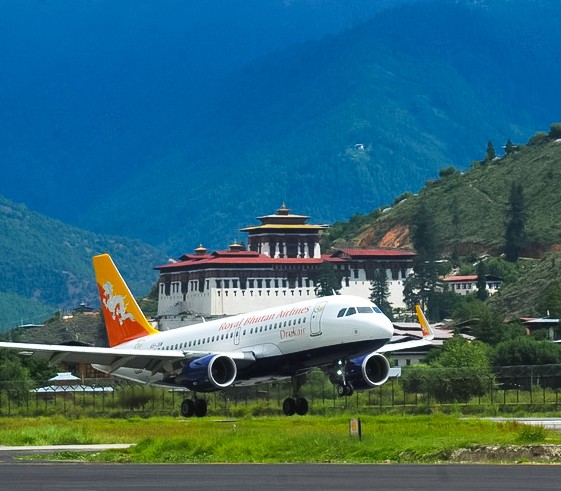
As we approach Bhutan, we see the massive peaks of the eastern Himalaya, including Kanchenjunga, the world’s third highest peak, and Jhomolhari, Bhutan’s holy mountain. Upon arrival in the Paro Valley and after completing visa formalities, your Bhutanese guide and driver will be waiting outside of the terminal to receive and escort you to our accommodations for the evening.
We begin our spiritual journey with a powerful butter lamp lighting ceremony at the 8th Century Kyichu Temple. The ceremony is performed to embark on a journey with safe passage throughout the kingdom. We will then stretch our legs on a short walk/hike back to our hotel following a farm road. Settle into the stunning Zhiwa Ling Hotel, a National Geographic Unique Lodge that celebrates the artistry of Bhutanese architecture and embodies the principles of the country’s Gross National Happiness initiative. Immerse yourself in the peaceful customs of the Bhutanese as you linger in the lodge’s intricate temple, meditation house, and tearoom.
Zhiwa Ling Heritage Paro is set on 10 acres in the Paro Valley, within easy reach of Bhutan’s most revered temples and monasteries. From its traditional Bhutanese architecture to its elegant temple made with 450-year-old timbers to its Swedish under-floor heating, the hotel seamlessly combines past and present.
·
This morning we take a short mountain flight to Bumthang. This flight offers spectacular views of the Himalayas and the valleys beneath crafted by the rivers that flow from the glaciers forming rich and fertile lands for settlements. To the right of the plain, the Black Mountain range is prominent. At the foothills of it lies the Monpa land that we shall visit in the next few days.
Once in Jakar Valley, we check into our hotel and freshen up. We then explore the 7th Century Jampa Temple and onwards to Kurje Lhakhang, where three temples are surrounded by 108 stupas. From Kurje we set off on foot to Tamshing Lhakhang, founded in 1501 by Pema Lingpa, a blacksmith from Bumthang who became one of Bhutan’s most revered Buddhist saints and teachers. Our walk wraps up at the Swiss Farm, a development project started in the 1960s when Swiss cheese-maker Fritz Maurer brought his skills to Bhutan.
Six Senses in Bumthang, is a luxury resort carefully built "forest within a forest" featuring eight spacious and beautifully-appointed suites and villas.
After breakfast, we drive a couple of hours to arrive in the buckwheat growing valley of Tang, one of the four valleys of Bumthang. Tang combines immense natural beauty with a history of hosting the greatest collection of eminent spiritual practitioners. One such spiritual leader, Longchen Rabjam, and his descendants have built the Ogyenchholing, the palace of bliss. We will take a tour of this now private museum and if we get a chance, we will meet the host Azhi Kezang Choden who is also a Bhutanese writer.
On the way back,stop by to visit Pemachholing Nunnery, home to 300 Buddhist nuns and practitioners of the powerful drum ceremony. The hymns from the Buddhist text are sang in tune with the hand-held drum and bell. We may interact with some of the few English-speaking nuns to understand their ordained lives and their choice to live in celibacy.
We have an opportunity for a short hike to the Burning Lake, or Mebartsho, where the king of treasure revealers, Pema Lingpa, is said to have performed his first miracle here uncovering the sacred treasures hidden by Guru Rinpoche in 8th century.
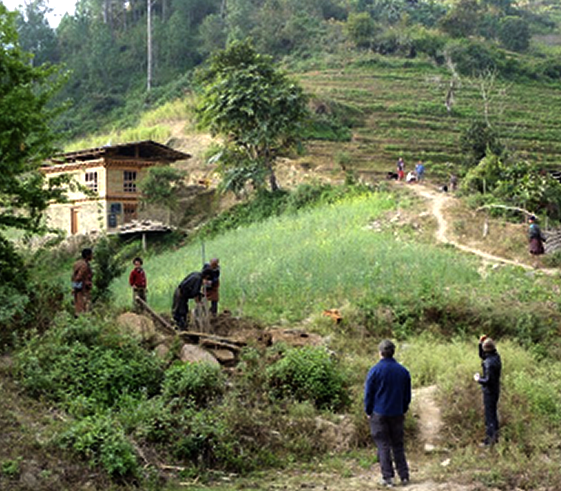
We drive from Bumthang to Trongsa across the Yutong La (“la” means “pass”) of 11,300 ft. Our 2-hour journey on the newly constructed road is scenic and may have some wildlife sightings. Reaching the bustling village of Trongsa on the hillside is a watchtower (the Ta Dzong) with an excellent example of the medieval fortresses that controlled Bhutan well into the mid-20th century, stimulates the senses with its intricate maze of buildings and temples and wondrous views of the valley. And then walk down to Trongsa Dzong. Bhutan’s dzongs originally served three purposes: they were fortresses, administrative to the most obvious centers for local government, and a residence for the monks and place for their religious activities. In days of yore—during Tibetan invasion or wars between the valleys— dzongs also acted as strongholds, protecting their vale’s inhabitants.
Afternoon we proceed further south for about 3 hours, taking a farm road to the village of Jangbi, where the Monpa reside and our home for the next two nights. Our Bhutanese guide will present a camp orientation. The local community of Monpa people, led by the resident Buddhist monk, will welcome us with folk song and dances and offering of fruits and local wines.The Monpas practiced Bon or Shamanism long before the advent of Buddhism. The resident monk has been appointed by the government to benefit the people in their spiritual pursuit of happiness. The few shaman masters do visit this village, reach out to the spirit world and channel these transcendental energies into the lives of the Monpas.
Our two nights in Jangbi will be accommodated in a Custom Built Tents built in walkin tents; the camps provide altogether a different experience of outdoor recreation in the wilderness. Meals will be cooked by the chef and a camp manager will ensure that your comforts are well looked after.
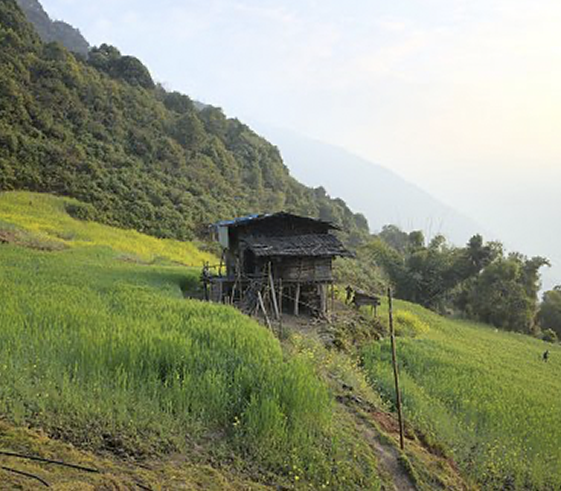
Today is an exciting day for us in the Monpa community! We peek into the lives of the Monpa people through firsthand experience. Our activities include hike to Wangling village with about 25 households. Visit the community temple and one of the farmhouses pounding rice, ploughing the fields with traditional equipment, grinding corn with traditional mill, playing traditional sports like darts and archers and participating in various farm tasks and interacting with the Monpa people.
Back in the campsite, we will cook a dinner for Monpas. Our camp cooks will guide you through hand-written recipes to prepare local dishes such as the ema datse, butter tea and other local favorites. We will all participate in preparing food for the Monpas to enjoy this evening. After a sumptuous meal, the Monpas will proudly demonstrate their traditional Monpa tribal dance. The night will be followed by story telling of Monpa healing practices by Ap Tawchu (healer) and if you are interested the healer may find out your problems and root out the probable cause of pain in your body.
Wangling Hike;
Distance: 4.3Miles/7Kms Time: 3 ½ Hours return easy
Elevation gain: Elevation loss:
We depart for the stunning Phobjikha Valley. Our 6 hours route climbs from the subtropical greenery of Trongsa to alpine regions featuring vast hemlock and rhododendron forests. This valley is home to the endangered black-necked cranes and the conservation efforts of Bhutan and WWF have created a safe haven for these beautiful birds, which flock the marshy wetlands in winter for roosting and a visit to the Crane Center sheds light to this legacy.
Afternoon enjoy nature trail hike along the ridge of Phobjikha valley. The trail is gentle and easy through pinewoods and countryside and whole of the time keeping yourselves along the ridge and wetlands onto your right. Submerge yourself with nature and look out for closer spots to see the roosting sites of these birds in winter. The hiking trail ends at Khewang Lhakhang, one of the oldest temples in the valley and today monastic school for the monks. The car will pick up and drive you to Khebethang village where you will see clustered of Bhutanese houses. Visit one of the farmhouse to get a glimpse of rural Bhutan and interaction with the families. Also if time permits, visit the crane center to learn more about these revered birds and how the community here live in harmony with them.
Gangtey Lodge, Gangtey, nestled in the beautiful Gangtey Valley, this hotel offers sweeping views of the lush Himalayan landscape. Complete with a fireplace and wall to ceiling windows, each guestroom is furnished with earthen tones and warm fabrics to echo the natural surroundings and rural architecture of Bhutanese heritage.
Nature Trail Hike;
Distance: 1.8miles/2.99Kms
Time: 1.5 Hours easy
Elevation loss: 140m/462ft
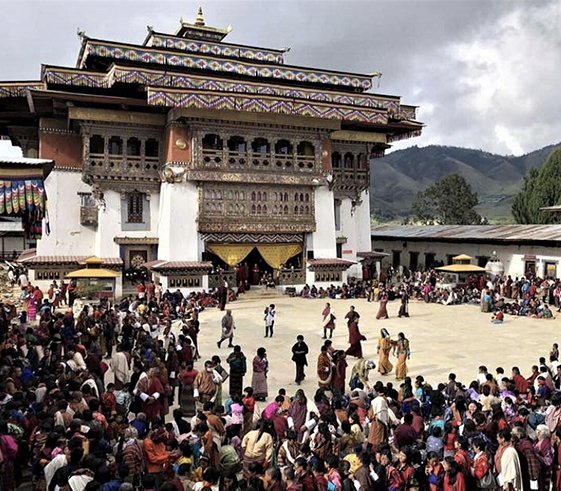
No single event captures the prevailing Bhutanese culture better than the Buddhist festival. The best known are the Tsechus, occasions honoring the significant accomplishments of Guru Rinpoche, the 8th Century figure widely revered across the Himalayas as the Second Buddha. Dancers in spectacular costumes perform tightly choreographed moves to a cacophony of drums, horns and cymbals. Constant chanting drifts in waves, a solemn base rising to vivid peaks.
What makes such occasions particularly remarkable is the manner in which performance merges with the overall setting. The larger festivals take place in the shadows of imposing fortress-monasteries, attracting large crowds from the surrounding region. For Bhutanese, they represent both the opportunity to concentrate on their religion and as major social occasions. We have arranged your trip in Bhutan just in time to get a chance to experience one such festival in Gangtey Monastery today. The event takes place for 3 days with devotees flocking in from all over the valleys and mountains and taking time to meet and get blessing and be merry.
In the evening attend evening prayer ceremony being performed daily by the monks in Gangtey Shedra (Buddhist College) and concluding with half an hour Q&A session with one of the teachers here.

Our drive to Punakha, the ancient Capital of Bhutan, is quite scenic. You will notice the change in vegetation from alpine highland to cactus-growing rich valleys of Wangdi and Punakha. Punakha Dzong, dominating the confluence of two rivers. Built in 1637 by Zhabdrung Rinpoche, Unifier of Bhutan, this massive fortress is one of the holiest in Bhutan, holding some of the most sacred relics including the preserved remains of Zhabdrung himself. The central monk body of Bhutan moves from Thimphu to Punakha every winter to take advantage of Punakha’s temperate climate.
Upon arrival in Punakha, set out on a hike through the surrounding rice paddies to Chimi Lhakhang—a temple blessed by Drukpa Kunley, known as the "Mad Saint." Hike around the village of sobsokha and meet farmers working in the fields. The farmers will welcome you to participate in the farming activities and lead a hand to the hard labor at the farms.
Late afternoon, visit the impressive Punakha dzong and exemplary fortress displaying the art and architecture of Bhutan. The Punakha Dzong also known as the palace of bliss, is the winter residence of the monk body of Bhutan. Here we will meet a senior monk, welcoming us to his private residence and engage in question answers understanding his way of life having spent so many years under Buddhist studies and a life of salvation under strict religious vows.
Six Senses, Punakha is perched at 1,400 feet, with rice terraces unfurling down into Punakha Valley promises warm luxury in one of the most extraordinary locations you’ll ever visit.
Chimi Lhakhang Hike;
Distance: 1.2Miles/2Kms
Time: 1.5 Hours return easy
Elevation gain: 20m/66ft
Elevation loss: 20m/66ft
Today we drive to Thimphu climbing up towards magnificent Dochula Pass at 10,000 ft with an amazing views of the eastern himalayas. We descend to Thimphu for exploration and sightseeing, on our city experience in the capital city of Thimphu, the largest and most modernized town in Bhutan. Thimphu is home to the ministries, international organizations and Royal Families of Bhutan, including His Majesty’s office.
One of the visible sights in the city is Memorial Stupa built in memory of the third king of Bhutan. People from all walks of life visit the stupa to offer prayers and circumambulate the monument to gain merit. It is a good spot to observe and meet the locals, whilst offering butter lamps here for your loved ones back at home and for the benefit of all sentient beings.
Then visit a wildlife sanctuary for the takin, Bhutan's national animal, described as having the body of a cow and the head of a goat. Finally end your day with a walk from the zoo towards your lodge- 30 minutes.
Zhiwaling Ascent is located just outside the center of the capital city in a park like setting with panoramic views. This contemporary concept hotel, which is the first of its kind in Bhutan, has 20 spacious rooms designed in the most energy efficient way to capture sunlight all day and provides superb views of the surrounding scenery. Like its sister hotel in Paro, it is wholly Bhutanese owned and operated.

In the morning drive up to see the tallest seated Buddha statue in the world facing towards the East, bestowing infinite love and compassion to all sentient beings in the spheres. The statue houses enormous meditational house in the base and two storied chapels on the top floors. You will be fascinated at fine art works crafted by the local artisans. The site also offers a good view of the valley below.
Local shops entice with traditional weavings; Tibetan and Bhutanese silverwork; coral and turquoise beads and prayer flags. A number of cottage industries, including metalworking and paper making, are found in Thimphu, and visitors often enjoy visiting their workshops to see artisans practicing their craft.Depending upon the interest of the group, there are couple of major sightseeing; National Textile Museum, where Bhutan’s finest weavings and brocades are on display, School of Zorigchusum where students undergo 4 years training in traditional arts and crafts. Gain insight into rural Bhutanese life at the Folk Heritage Museum, a replica of a traditional mud-and-timber farmhouse. Observe the delicate artistry involved in creating deh-sho, or locally handmade paper, at the Jungshi Paper Factory.
On our second evening in Thimphu, we are honored to meet, dine and converse with Bhutanese dignitaries on topics of interest. Most participants say this is one of the highlights of their trip!
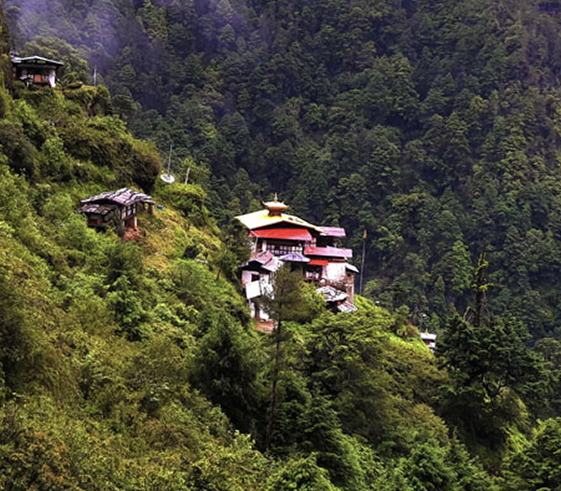
Early in the morning travel through the emerald rice paddies and quaint farming villages of the Paro valley and drive until the road point to start your hike to the Sacred Chumphu Nyethrough pine, oak and rhododendrons vegetation. The walk is flat with minimal risealong the bank of Pacchu river until the last section of the trail at a bridge located at the base of the hill on which Chumphu Ney sits.
From the bridge, the climb wandersthroughnumerous sacred caves, rocks and waterfalls associated with Guru Rinpoche, Dakinis and Saints who has meditated and graced the place and have left around many sites blessed \with his body prints. The main statue inside the Chumphu temple is the statue of Dorji Phagmo which is alsobelieved to fulfilling the prayers and wishes of the pilgrims. The temple also has some exquisite wall murals of saints and Buddhist masters.
Late afternoon, we trace back the same route to our campsite below near the river bank.
Custom Built Tents in walkin tents, the camps provide altogether a different experience of outdoor recreation in the wilderness. Meals will be cooked by the chef and a camp manager will ensure that your comforts are well looked after.
Chumphu Ney Hike;
Distance: 8.7Miles/14Kms
Time: 7-8 Hours return
Elevation gain: 700m/2,300ft
Elevation loss: 700m/2,300ft
Today you will drive back to Paro valley for sightseeing around. Visit the National Museum of Bhutan located inside the Ta Dzong which once acted as the watch tower for the Paro Dzong below. Few minute’s drive below is the Paro Rinpung Dzong. Admire the impressive architecture of the Paro Dzong, a stronghold that once defended the country from Tibetan invasions. Later walk down towards cantilevered bridge spaning over Pachu river to visit a painting gallery where local painter will be working on his masterpiece. You can also check out some of his works showcased in his art shop. In the evening stroll around Paro own for last minute shopping and souvenir.

We embark on an invigorating morning hike to Taktsang Monastery, Tiger’s Nest, one of the most iconic and venerated Buddhist monuments in the Himalayas. Set into a cliff face 2,600 ft. above the Paro Valley, the Tiger’s Nest takes its name from a mythical journey made by Lord Padmasambawa, Guru Rinpoche, who flew there on a tigress’ back in order to meditate for three months and convert the valley to Buddhism. Many of Buddhism's most influential figures have paid homage to this site.
The hike is about 1.5 hours and well worth the effort! About halfway up, we stop at a teahouse and the view from there alone is well worth the climb. Another 45 minutes brings you all the way to the gompa. The main building of Taktsang was badly damaged in a fire, and underwent a major restoration in 2003.
In the afternoon, we soak in the luxury of the hotel and or explore and shop in Paro town. In the evening, we celebrate our journey and new friends with a delectable farewell dinner at our beautiful hotel.
Tiger’s Nest Monastery Hike;
Distance: 8.2Miles/13.2Kms
Time: 5-6 Hours Return
Elevation gain: 700m/2,300ft
Elevation loss: 700m/2,300ft
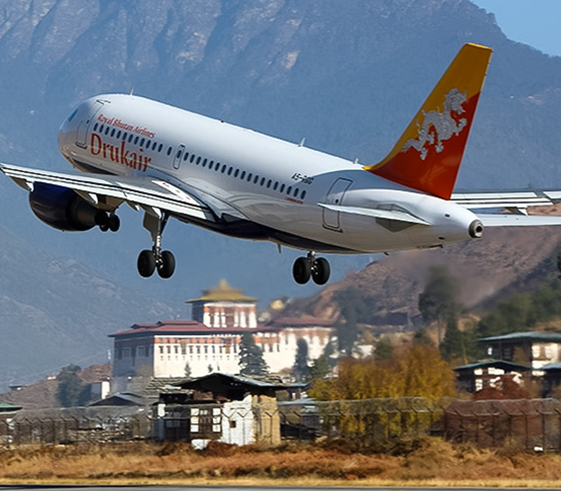
We bid farewell to our newfound friends of Bhutan. Your guide and driver will accompany you to the airport for your departure in the morning. We wish you safe flight and Bon Voyage.



